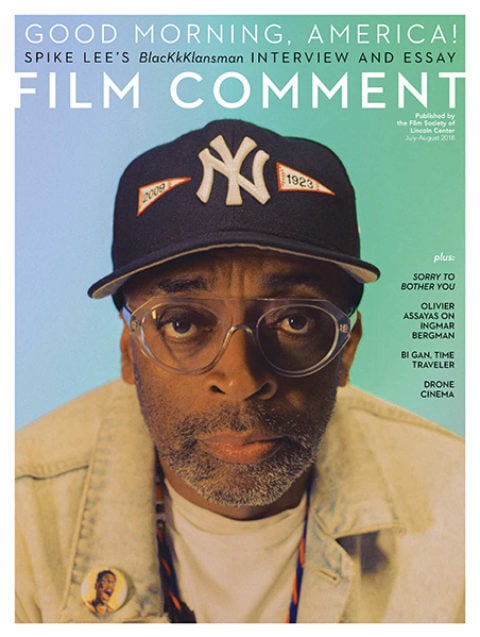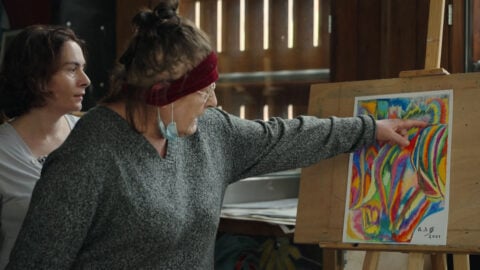Key
⦿DVD /★DEBUT
⦿BLU-RAY /★DEBUT
▸STREAMING
▸EXCLUSIVE TO VOD
Allan Dwan & Douglas Fairbanks x 2:
The Good Bad Man, USA, 1916; The Half-Breed, USA, 1916; Kino Lorber
In 1916, the release year of this pair of early Westerns featuring Douglas Fairbanks as a man whose sense of fair play and uncertain lineage renders him an outsider in an already corrupt frontier society, director Allan Dwan was credited with inventing the crane shot on the set of D.W. Griffith’s Intolerance. No such film-historical breakthroughs are on display here, but there’s ample evidence of the visual economy and mathematical precision with which Dwan drafted his plots. In The Half-Breed—distinguished by awesome location shots in the Sequoia National Forest and titles written by Anita Loos that take a scourge to racist hypocrisy—the tangled trio at the center is half–Native American Fairbanks, a preacher’s daughter, and the man who, unbeknownst to all, is Fairbanks’s character’s father. The Good Bad Man comes to us only as a 1923 condensation, but it is enough to see in Fairbanks’s dashing desperado the progenitor of a thousand outlaw heroes to come.—Nick Pinkerton
The Ballad of Gregorio Cortez
Robert M. Young, USA, 1982; The Criterion Collection
1901. Gonzales, Texas. A sheriff investigating the rustling of livestock shoots his interpreter-deputy Romaldo Cortez after he fails to parse a difference between “horse” (caballo) and “mare” (yegua), and is killed by the man’s brother Gregorio in return. The murky incident, Gregorio’s subsequent 10-day manhunt, and his eventual conviction and pardon would inspire folklore, poetry, corridos, and the Américo Paredes novel that provided the basis for this film. The Ballad of Gregorio Cortez is framed by the investigative prodding of a reporter (Bruce McGill), which allows for vying perspectives of Cortez (Edward James Olmos) as cold-blooded cop-killer, prejudice-defying hero, or the unlucky mortal in between—and lets Robert M. Young probe the vagaries of myth and history in the form of a stimulative chase and survival (then courtroom) picture, outfitted with pleasantly period-incorrect synths that complement the director’s documentary-trained realism.—Justin Stewart
Cargo
Ben Howling & Yolanda Ramke, Australia, 2017; Netflix
At two points in Cargo, Andy (Martin Freeman) lets out a larynx-shredding yell. He’s living through a zombie pandemic, and he made the snap judgment call to mercy-kill his wife after she was bitten—only to get infected in the process. With just 48 hours until irreversible zombification, he must traverse the undead-ravaged Australian Outback to find new guardians for his chubby-cheeked baby daughter, Rosie. The overall mood isn’t panic but a hopeless fatigue: as co-directors Ben Howling and Yolanda Ramke flesh out the survivors’ coping mechanisms, it seems less and less likely that Rosie will be raised to respect what remains of her community or her world. Through its landscape of environmental decay and racial oppression, Cargo implies that we brought this plague on ourselves; although the film is distractingly gun-shy about close-ups of zombies, it finds deeper scares among the living. A wearied Freeman carries the movie, even when the only thing to do is scream.–Chloe Lizotte
The Changeling
Peter Medak, Canada, 1980; Severin Films
Survivor guilt can be deadly—especially when there’s a furious child-ghost to contend with. In Peter Medak’s 1980 grief- horror classic The Changeling, pianist John Russell (George C. Scott) flees New York for a spooky Seattle mansion after a truck mows down his family. Yet his fortress of solitude turns out to be a haunting ground—all ominous knocking and plaintive whispers—and the film was shot by John Coquillon using vertiginous canted angles (forceful if old-fashioned next to The Shining, released two months later). Scott as John locates grace in a cathartic, slightly TV-detective-ish investigation of the house’s murderous forebears (cue Melvyn Douglas as a corrupt senator). Originally attached to directors Donald Cammell and Tony Richardson (as the disc’s extras remind us), the movie sealed Medak’s scaremonger bona fides, while perhaps also dooming the Hungarian exile’s freewheeling side. There’s no escaping sadness here—your own, or that of others—without a scratch.—Nicolas Rapold
Sweet Sweetback’s Baadasssss Song
Melvin Van Peebles, USA, 1971; Vinegar Syndrome
Sweet Sweetback’s Baadasssss Song, rogue in attitude and rough in texture, is for those reasons an odd choice for the bougie fetishism of Blu-ray culture. Otherwise, for this essential, infuriating landmark of American cinema, such pristine showcasing is, if anything, overdue. The movie remains epochally abrasive, turning its streamlined narrative about a shady black fugitive’s endless flight from repulsive cops into a 97-minute fuck-you to systemic racism, border patrolling, and the carceral state. These indictments could hardly feel timelier, even as Sweetback’s sexual politics elicit (and warrant) evergreen critique. The film’s experiments with eclectic sound, febrile image-making, and fractious montage are as intrepid as its rhetoric, conjuring Melvin Van Peebles as the Kenneth Anger of black anger, a Ralph Ellison of the obscene screen.—Nick Davis
Vigil
Vincent Ward, New Zealand, 1984; Arrow Video
The everyday emotional storms of childhood—equally parts magical thinking and pitiless observation—are notoriously thorny for adults to parse. The heart of New Zealand filmmaker Vincent Ward’s 1984 Vigil is preadolescent Toss (Fiona Kay), whose austerely idyllic life on the family sheep farm is shattered when her father dies in an accident precipitated by drifter Ethan (Frank Whitten), soon to be her mother’s lover. Ward’s eye for subtle shifts in the air, emotional and physical, drives Vigil’s minimal narrative. But its soul is Toss’s animistic relationship with the otherworldly landscape of rural New Zealand, a prickly paradise of lush grass and bone-shattering cliffs, twisted trees, scudding mist, and sucking mud flats. It’s no wonder she can imagine a runaway tractor might be sentient… Equal parts eerie and lyrical, Vigil lies between the melancholy of Forbidden Games and the ruthlessness of Let the Right One In.—Maitland McDonagh








